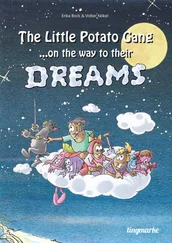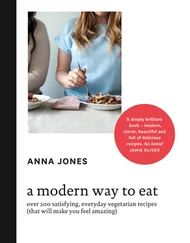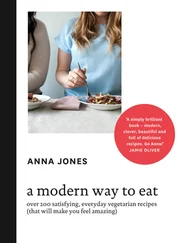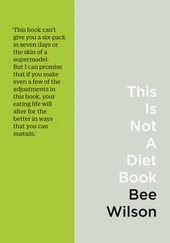As in South Africa, the pattern of eating in Mexico has changed, radically and fast. We are not talking here about the occasional fizzy drink or a Friday night plate of fried chicken but a near total transformation of the food supply, which has gone hand in hand with disastrous changes to the population’s health since the 1990s. From 1999 to 2004, 7-Eleven doubled its number of stores in Mexico. There are Mexican towns where running water is sporadic and Coca-Cola is more readily available than bottled water. Meanwhile, the prevalence of overweight and obesity among people in Mexico rose 78 per cent from 1988 to 1998 and by 2006, more than 8 per cent of Mexicans were suffering from type 2 diabetes. 50
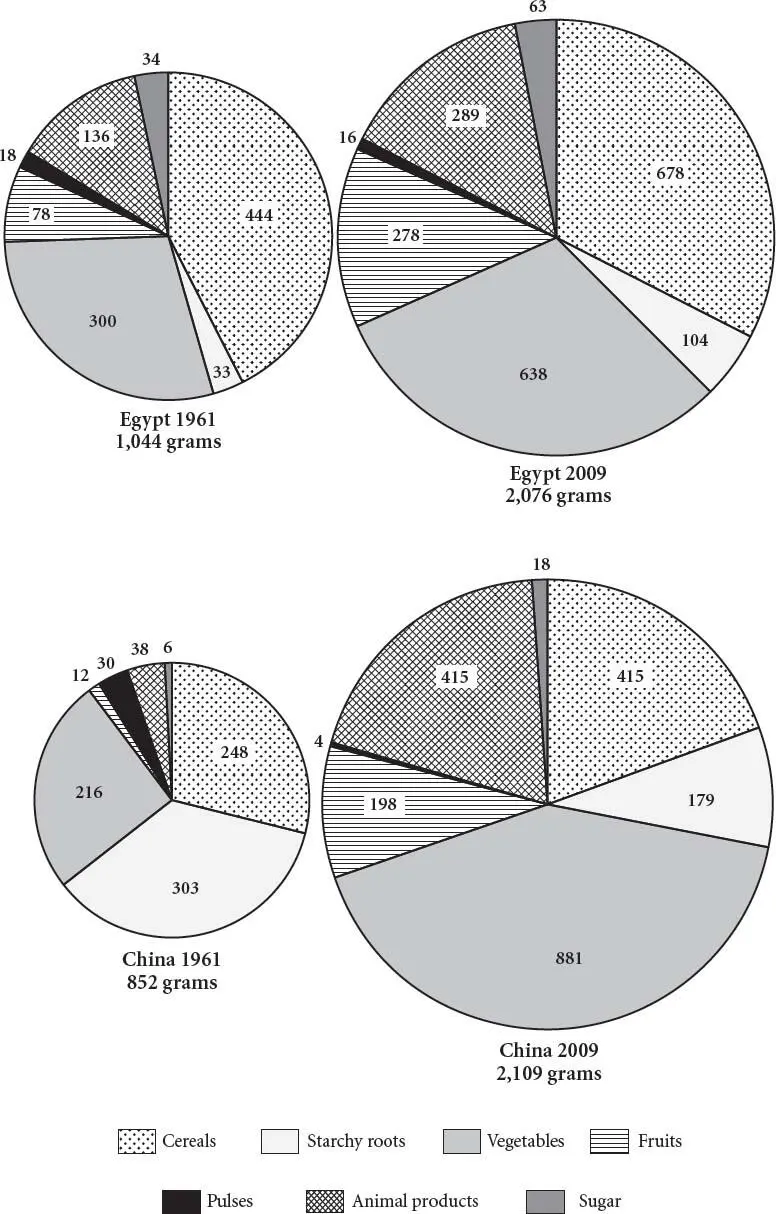
A changing plate of food in China and Egypt in 1961 and 2009.
A similarly tragic nutrition transition is currently playing out in Brazil, where much of the population is both malnourished and obese. Throughout Brazil there are ‘dual burden households’ where some family members (usually the children) are underweight and stunted and others (usually the mothers) are obese. 51Many adolescent girls in Brazil are both anaemic and obese, suggesting that their diets, though plentiful, are low in crucial micronutrients, especially iron. 52
To Americans, junk food is nothing new. Cracker Jack, a sticky packaged confection made from popcorn, syrup and peanuts, was first sold in Chicago in 1896. The difference now is the sheer global reach of branded processed items, which have succeeded in travelling to some of the remotest villages in Africa and South America. From the late 1990s onwards, the multinational food companies worked hard to get their products into even the tiniest village food stores in Africa. As soon as electricity reached a given region, Coca-Cola would be there, offering free coolers and kiosks to shopkeepers who would stock their products. But now, food companies have taken this marketing a stage further, employing travelling salespeople to bring branded processed foods right into individual homes. 53
In 2017, reporters from the New York Times followed some of the women who act as door-to-door salespeople for Nestlé in Brazil. Items such as chocolate pudding, sugary yoghurts and heavily processed cereals are sold door-to-door to consumers who may believe they are doing the best for their families by buying these products, which often boast that they are fortified with vitamins and minerals. In the poorer regions of Brazil, door-to-door sales enable multinational food companies to reach households they could never otherwise have penetrated. 54
A report on the Nestlé website in 2012 boasted about door-to-door sales as a form of ‘community engagement’ because the foods being sold were fortified with vitamins. What the report doesn’t mention is that these fortified foods contain excessive amounts of sugar and refined starch and are displacing other, more nourishing foods from the Brazilian diet. The company currently had 7,000 saleswomen going door-to-door in Brazil, but aimed to expand this number to 10,000. Nestlé claimed that the initiative brought a sense of ‘independence’ as well as valuable income to the female sellers. Needless to relate, the company said nothing about the fact that most of these women – like their customers – were now grappling with diet-related ill health. A reporter for the New York Times spoke to Celene da Silva, a 29-year-old seller for Nestlé, who weighs more than 200 lb and has high blood pressure. She drinks Coca-Cola at every meal. 55
This is a story not just about the food industry but about social change. The rise of the big multinational food companies in Brazil and elsewhere is part of a bigger picture which includes rising incomes, changing patterns of work, urbanisation, electronic kitchen gadgets and a growth in TV, computer and mobile phone ownership. Mass media is one of the drivers of the nutrition transition that we often forget about. In China in 1989, only 63 per cent of households owned a TV set and of these, half owned a black and white set. By 2006, 98 per cent of Chinese households owned a TV, and almost all of them showed a full colour picture. TV watching not only encourages people to be less active than ever before, but it also allows direct marketing of novel processed foods, particularly to children. Almost all the food advertised in the world on TV is what nutritionists call ‘noncore’: inessential, sugary or salty snack foods rather than those served for a main meal. The aim of the adverts is to create a preference for these unhealthy foods in children which, the manufacturers hope, will last a lifetime. 56
It’s not that electronic entertainment or labour-saving kitchens and city life are bad in themselves – to the contrary. Speaking for myself, I would hate to go back to a life before Spotify – never mind before refrigeration and colour TV. So many of the social changes that have gone along with the nutrition transition have enabled people to lead fuller, easier, more comfortable lives. In the spring of 2018, when I visited Nanjing, one of the biggest cities in China, I walked on ground that would have been farmland ten years ago, full of workers doing back-breaking labour in the fields. Now, these neighbourhoods were full of glitzy high-rise malls where young people whose grandparents had lived their youth in toil and hunger sat in air-conditioned branches of Starbucks nibbling fluffy cakes flavoured with green matcha tea. Older Nanjing residents who would once have struggled to afford exotic fruit such as durian or lychees more than once or twice a year could now buy these fruits every week, and carry them home on a super-fast metro train.
In a way, the modern global food industry is a miraculous achievement. It can grow anything, transport anything, sell anything (so long as that anything can be neatly packaged and placed on a supermarket shelf). The system can produce fresh green beans and perishable meat in a far-flung corner of one country and distribute them, still in an apparently fresh state, to hungry eaters anywhere on the planet in a matter of days. For those with the cash to buy them, there are summer fruits in winter and sweet cups of piping-hot chocolate topped with whipped cream all the year round. Where our ancestors worried intensely about the safety of dairy products, we can now buy fresh refrigerated cold milk, mostly free of pathogens, whenever we feel like it.
The food transformations of stage four are unlike anything else the world has seen. Sometimes, I look at my three children and think how extraordinarily fortunate much of this generation is, never having to doubt whether there are things to eat in the shops. Fresh fruit is almost like running water to them. When stuff in our refrigerator runs out, we know there is plenty more where it came from. My children have never known empty shelves or rationing. Nor have I, come to that.
Needless to say, it still isn’t possible for all children, everywhere, to rely on this diet of abundance, even now. The terrible food shortages in present-day Venezuela are a bleak reminder that we cannot necessarily count on this era of plenty lasting for ever. It’s also the case that many children, even in rich countries, are not sharing in the plenty to the same extent, with one in five American children suffering from food insecurity. Stage four has seen the emergence of new forms of social and economic inequality around food. Some children have never tasted a strawberry, except for the fake strawberry flavour in a fast food milkshake. Others – from wealthier families – are given organic oats and farmers’ market berries for breakfast. The gap in quality between the diet of the poorest and that of the richest is wide and widening. The poorest families in America may not look hungry in the way that Victorian orphans looked hungry but they eat fewer dark green vegetables, fewer wholegrains and fewer nuts. 57
Читать дальше



